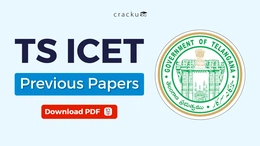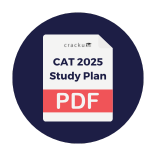The Common Admission Test (CAT) is a highly competitive examination to get into the prestigious management institutes in India. It comprises 3 sections - Verbal Ability Reading Comprehension (VARC), Data Interpretation Logical Reasoning (DILR) and Quantitative Ability(QA).
Of all the other sections, the VARC section is the most predictable and the most scoring. CAT Reading Comprehension Questions hold paramount importance in this section and test the candidate's reading ability with an analysis of written material. The RC passages in CAT previous papers have been derived from a variety of sources, reflecting diverse topics and writing styles. CAT RC Passages with Solutions shall help in understanding better how to prepare for the RC section of the CAT.
CAT Previous Year RC Passages PDF
To prepare for the CAT exam, practicing with CAT Previous Year RC Passages PDF is highly recommended. These PDFs give insights into past exam patterns and questions, helping improve reading speed, comprehension, and test-taking strategy. Downloading the PDFs provides valuable practice material and aids in identifying recurring themes and question types for a focused preparation approach. We have provided the link to download the CAT RC Passages PDF below, Enhancing access to essential resources to improve exam performance.
Common Themes in RC Passages
In the following, we have mentioned the common CAT RC passages that are common across years. Checking with the CAT Exam Syllabus will help you to find other uncommon types across years.
Social and Economic Issues: Discussion on poverty, inequality, globalization, and economic policies.
Science and Technology: Articles on scientific discoveries, technological developments, and their impact on society.
Philosophy and Psychology: Passages that deal with philosophical ideas, human behavior, and psychological theories.
History and Culture: Narrations of historical events, cultural practices, and their importance.
Environment and Ecology: Texts related to environmental problems, conservation efforts, and ecological studies.
It has often been seen that popular topics of the year often end up as CAT Reading Comprehension.
RC Sources of Past CAT Papers
Newspapers and Magazines
Newspapers and magazines are one of the primary sources of RC passages. They carry a variety of articles related to news events, editorials that embody diverse opinions, and in-depth analyses of various social issues. Sources of note include:
Academic Journals
Academic journals are another source of more scholarly and research-oriented passages. Passages often comprise intricate arguments with detailed supporting evidence which are tougher but very helpful in honing analytical skills. These sources are certainly no stranger to anyone and include the following sources:
Books and Essays
Excerpts from books and essays can make for a very enriching and diverse read. They can range across fiction and non-fiction, or even span from biography to philosophical treatise. The most common ones are:
Online Articles and Blogs
The internet contains a good number of articles and blogs on every imaginable topic. These sources are increasingly used for RC passages because of their relevance and accessibility. Some prominent sources include: Aeon Essays and The Guardian, The Economist etc.
To enhance your preparation, you can download CAT Previous Year RC Passages PDF to get familiar with the types of questions and improve your comprehension skills
Sources of CAT RC Passages in 2024
| Slot | RC | Direct Sources | Difficulty |
|---|---|---|---|
| 1 | Craftsmanship and creativity | The Economist | Medium |
| Bandicoots in Australia | The Smithsonian | Medium | |
| Digital rights of content | The Guardian | Easy | |
| Behavioural economics | Public Books | Medium | |
| 2 | Spice Trade | Yale Global | Medium |
| Consequences of Technology | NY Times Magazine | Medium | |
| Peer Review of Research | Nature.com | Medium | |
| Animals Vs Humans | Vijesti.me | Difficult | |
| 3 | AI Regulation | The Economist | Medium |
| Contamination of space | Foreign Policy | Medium | |
| Moutai madness | The Economist | Medium - Difficult | |
| Languages | Huffpost | Medium - Difficult |
Sources of CAT RC Passages in 2023
| Slot | RC | Direct Sources | Source | |
| 1 | Wolf | The Economist | Magazine | |
| Change in Work Culture | Jared Diamond | Online Article | ||
| Indian Ocean | The Conversations | Online News Article | ||
| Human Behaviour | Public Books | |||
| 2 | Fast Fashion and Pollution | Prospect Magazine | Magazine | |
| Translated Netflix in Europe | The Economist | Magazine | ||
| Falling of Liberalism | The Economist | Magazine | ||
| Historical Facts and Interpretations | What is History | Book | ||
| 3 | Global Warming and Colonialism | The Wire Science | Magazine | |
| Romantic Aesthetics | Stanford Encyclopedia of Philosophy | Academic Journal | ||
| Archaeology Paradox | The Los Angeles Times | Newspaper Magazine | ||
| Rationality | The Washington Post | Newspaper Magazine |
Sources of CAT RC Passages in 2022
| Slot | RC | Direct Sources | Source | Difficulty |
| 1 | Stoicism | Aeon Essays | Article | Easy |
| Critical Theory | Encyclopedia of Emotions | Book | Easy | |
| Undead | Encyclopedia of the Undead | Book | Easy | |
| Copies of Copies | University of Witwatersrand, South Africa | Journal | Medium | |
| 2 | Octopuses | Scientific American | Article | Easy |
| Engineering Problems | Encyclopedia of the Undead | Book | Medium | |
| Music | Million Years of Music | Book | Medium | |
| Social Institutions | SAGE Handbook of Philosophy of Social Sciences | Book | Medium | |
| 3 | Sociology of Crime | Wall Street Journal | Article | Easy |
| Logic of Bios | 'The Penguin History of Early India' | Book | Medium | |
| Orientalism | Out of Control | Book | Medium | |
| Automation | i-Researchnet | Journal | Medium |
Sources of CAT RC Passages in 2021
| Slot | RC | Direct Sources | Source | Difficulty |
| 1 | Cuttlefish | Smithsonian | Article | Easy |
| Dystopia | Aeon Essays | Article | Easy | |
| China Tea | Financial Times | Article | Medium | |
| Maya | Oystopia | Book | Medium | |
| 2 | Truth | The New York Times | Article | Easy |
| Nationalism | Nepali Timess | Article | Medium | |
| Multilingualism | Empire & Nation | Book | Medium | |
| Problem of Knowledge | Scandalous Knowledge | Book | Difficult | |
| 3 | Growth of Unconscious | New Scientist | Article | Easy |
| Nano Robots | New Scientist | Article | Easy | |
| Languagae | The New York Times | Article | Medium | |
| Measuring Time | JSTOR | Journal | Difficult |
Sources of CAT RC Passages in 2020
| Slot | RC | Direct Sources | Source | Difficulty |
| 1 | Anarchism | The Atlantic | Online Article | East |
| Textiles as Money | Anarchism | Book | Easy | |
| Writing | On Writing | Book | Medium | |
| Elephant Seal Dialects | Cambridge University Press | Journal | Difficuly | |
| 2 | Divestment | The Spectator | Article | Easy |
| Visual Culture | The Sacred Gaze | Book | Medium | |
| Aggression | Blackwell encyclopedia of Sociology | Journal | Medium | |
| Piracy | MIT Press Direct | Journal | Medium | |
| 3 | Human Geography | The Guardian | Article | Easy |
| Political Philosophy | The New York Times | Article | Medium | |
| Human Contact | Encyclopedia of Human Geography | Book | Medium | |
| Economic Crisis | Humankind: A Hopeful History | Book | Difficult |
Tackle CAT RC Passages
Usually for students, it is the VARC section for students that is very troublesome. The problem with VARC is that all options, at most times, seem correct. Because of this, you cannot be 100% sure if your section has gone well or not.
To approach the RC passages, one should keep the following strategies in mind:
- Active Reading: Engage with the text by annotating key points, underlining the most important ideas, summarize each paragraph.
- Identify the Main Idea: Focus on the central theme or the argument of the passage.
- Understanding the Context: Notice the context within which words or phrases have to be used to draw inferences.
- Critical Reasoning: Check for arguments' consistency; identify biases, if any; and find alternative opinions.
- Time Management: Read passages in a time-limited framework to check your reading speed without compromising on comprehension.
Practice for CAT RC
Practicing regularly is the only thing that can help you score better in this section. Unfortunately, learning a language is a tougher skill than QA. To aid the process. you can regularly practice RC skills with:
- CAT Papers: Past RC passages from CAT exams.
- Mock Tests: Timed CAT mock tests, to simulate the actual exam environment.
- Reading Diverse Materials: Reading different types of reading materials in the sources mentioned above to build familiarity with various writing styles and topics. You can use the resources mentioned in the blog above.
Mastering the RC section in CAT desires not only continuous practice but also a strategy in place. If you have a good grasp of common sources for RC passages and develop effective reading and analytical skills, then you can easily perform way above your current level. Use the resources mentioned herein, implement these suggested strategies in your preparation, and you will feel confident enough to top the RC section and secure a high percentile in CAT.


![Top 10 - CAT Geometry Triangles Questions [Download PDF] Top 10 - CAT Geometry Triangles Questions [Download PDF]](/media/cache/95/e1/95e12a34d491e2927874fa1244dc3c71.webp)
![Top Important CAT Inequalities Questions [Download PDF] Top Important CAT Inequalities Questions [Download PDF]](/media/cache/3d/d4/3dd401b51d7eba1c5a876e968619b42e.webp)


![Top CAT Geometry Triangles Questions [PDF] Top CAT Geometry Triangles Questions [PDF]](/media/cache/2d/40/2d40909ccde09df6707398e3678e445f.webp)






